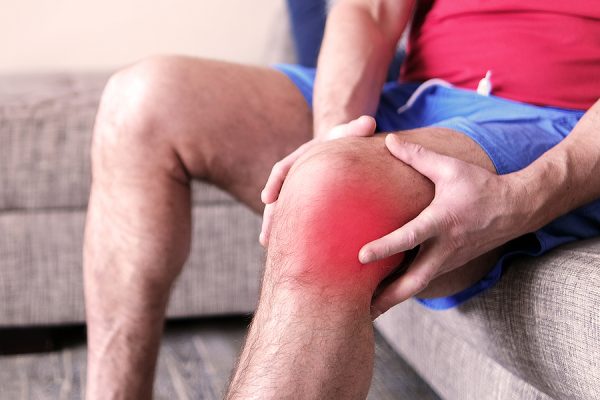By David Blyweiss, M.D., Advanced Natural Wellness
Your knees are important to you. You use them every time you sit, stand, walk, lift or jump. But when they become inflamed and irritated, it can become debilitating and interfere with even the simplest of daily activities.
Around one in every two adults will develop symptoms of knee osteoarthritis (OA) at some point in their lives. So even if you don’t have symptoms of knee (OA) yet, you have about a 50/50 chance of developing it the future.
However, new research out of Baylor College of Medicine shows that there may be away to prevent OA in the knees from becoming painful.
The researchers found that walking reduced the incident of new, frequent knee pain in people 50 years or older with knee OA. The walkers had a 40% decrease in the odds of developing pain than non-walkers. Not only that, but walking also appeared to slow the odds of damage that occurs within the joint by about 20%.
So keeping one foot in front of the other might just be one of the easiest ways to keep your knees pain-free – even if you’ve been diagnosed with osteoarthritis.
Take a Retro-Walk!
If you are already experiencing knee pain, the last thing you probably want to do is take a walk. You might even think the stress walking puts on the knees could cause further pain and damage.
So it might surprise you to learn that walking is one of the best ways to reduce pain, stiffness and inflammation, and to improve the health of knee cartilage in symptomatic OA patients. In fact, walking appears to work just as well to reduce pain and disability as quadriceps strengthening exercises like chair squats, sitting leg raises and standing leg lifts.
If you haven’t done much walking lately, I recommend starting off slowly. Instead of trying to go out for a 45-minute walk, break it down into three 15-minute segments with at least an hour of rest between them. This will help keep from overworking your sedentary knees, which could temporarily result in an increase pain.
And there is actually a way to boost the pain-relieving results of walking. If you are steady on your feet, just walk backward! It’s called “retro-walking.”
Compared to walking forward, backward-walking results in a greater reduction in both pain intensity and functional disability. It even works better than balancing exercises. Plus, it produces greater improvements in quadriceps strength and helps improve knee muscle activity.
But a word of caution. While walking can offer a great deal of relief and support for your knees, you could easily reverse some of those gains if you’re eating an inflammatory diet.
Foods That Aggravate Your Knees
While walking, quadriceps strengthening exercises and balancing exercises are all great for relieving knee pain and stiffness, eating the wrong foods can undo some of that good.
Specifically, sugar and other refined/high glycemic carbohydrates, salt, omega-6 fatty acids, red meats and dairy products all contribute to inflammation. And osteoarthritis is an inflammatory disease. The more inflammation in your body, the greater the progression of the disease.
So one of the best things you can do in addition to staying active is to eat a healthy anti-inflammatory, diet filled with plenty of fresh, plant-based foods.
Eating more of a plant-centric diet can significantly reduce pain and improve function in as early as two weeks. It can also help you lose weight. That’s a bonus, because it’s been shown that every 15 pounds lost reduces knee pain by 50% in overweight individuals with arthritis.
Take it step-by-step and one meal at a time to keep your knees in action and pain-free over the years.
SOURCES:
Walking for Exercise Can Benefit Older Adults With Osteoarthritis, Study Says. News Release. AJMC. June 2022.
Lo GH, Vinod S, Richard MJ, Harkey MS, McAlindon TE, Kriska AM, Rockette-Wagner B, Eaton CB, Hochberg MC, Jackson RD, Kwoh CK, Nevitt MC, Driban JB. Association Between Walking for Exercise and Symptomatic and Structural Progression in Individuals With Knee Osteoarthritis: Data From the Osteoarthritis Initiative Cohort. Arthritis Rheumatol. Jun 2022.
Roddy E, Zhang W, Doherty M. Aerobic walking or strengthening exercise for osteoarthritis of the knee? A systematic review. Ann Rheum Dis. 2005 Apr;64(4):544-8.
Alghadir AH, Anwer S, Sarkar B, Paul AK, Anwar D. Effect of 6-week retro or forward walking program on pain, functional disability, quadriceps muscle strength, and performance in individuals with knee osteoarthritis: a randomized controlled trial (retro-walking trial). BMC Musculoskelet Disord. 2019 Apr 9;20(1):159.
Krishnan V, Pithadia K. Effect of retro walking versus balance training on pain and disability in patients with osteoarthritis of the knee: a randomized controlled trial. Bull Fac Phys Ther. 26, 19 (2021).
Farrokhi S, Jayabalan P, Gustafson JA, Klatt BA, Sowa GA, Piva SR. The influence of continuous versus interval walking exercise on knee joint loading and pain in patients with knee osteoarthritis. Gait Posture. 2017 Jul;56:129-133. Clinton CM, O’Brien S, Law J, Renier CM, Wendt MR. Whole-foods, plant-based diet alleviates the symptoms of osteoarthritis. Arthritis. 2015;2015:708152.



